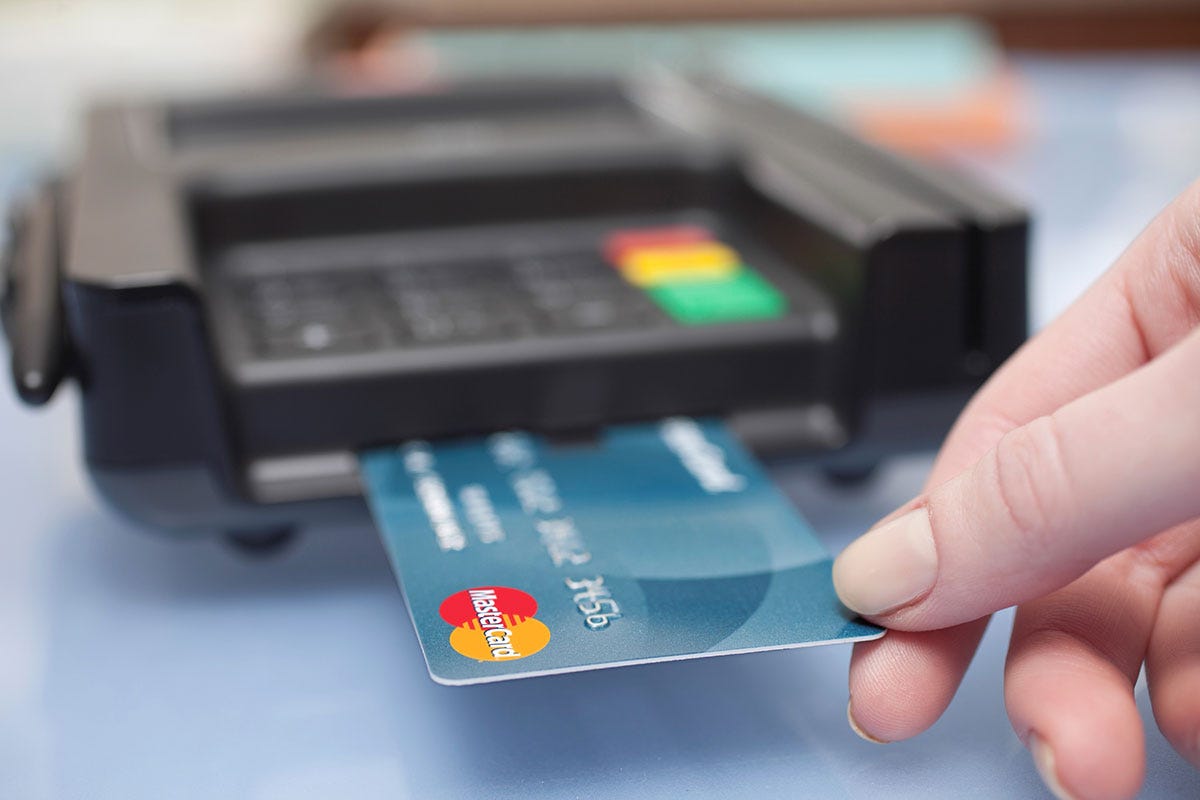Home>Finance>How Do EMV Chip Readers Work With The Payflow API


Finance
How Do EMV Chip Readers Work With The Payflow API
Published: March 6, 2024
Discover how EMV chip readers work with the Payflow API to enhance finance security and streamline payment processing. Explore the benefits today!
(Many of the links in this article redirect to a specific reviewed product. Your purchase of these products through affiliate links helps to generate commission for LiveWell, at no extra cost. Learn more)
Table of Contents
- Understanding the Revolution in Payment Technology
- Enhancing Security and Efficiency in Payment Processing
- Empowering Seamless Payment Integration and Customization
- Seamless Convergence of Secure Payment Technologies
- Elevating Payment Security with EMV Technology
- Forging a Path to Secure and Seamless Payment Experiences
Introduction
Understanding the Revolution in Payment Technology
In today's fast-paced digital era, the landscape of payment technology is constantly evolving to meet the growing demands of consumers and businesses. One of the most significant advancements in this domain is the widespread adoption of EMV chip readers, which have revolutionized the way transactions are processed and secured. EMV, which stands for Europay, Mastercard, and Visa, represents a global standard for credit and debit card payments based on chip card technology. This technology offers enhanced security features compared to traditional magnetic stripe cards, making it a crucial component of modern payment systems.
The integration of EMV chip readers with payment processing solutions such as the Payflow API has further propelled the efficiency and security of transactions, providing a seamless and reliable experience for merchants and customers alike. This article delves into the intricacies of EMV chip readers and the Payflow API, offering a comprehensive understanding of how these technologies work in tandem to facilitate secure and efficient payment processing.
As we embark on this exploration, it's essential to grasp the fundamental principles underlying EMV chip readers and the Payflow API, paving the way for a deeper insight into their integration and the robust security measures they offer. Let's embark on this enlightening journey to unravel the inner workings of EMV chip readers and the Payflow API, shedding light on their pivotal role in shaping the future of payment technology.
Understanding EMV Chip Readers
Enhancing Security and Efficiency in Payment Processing
EMV chip readers are designed to process payment transactions securely and efficiently by leveraging advanced chip card technology. Unlike traditional magnetic stripe cards, which store static data that can be easily replicated, EMV chip cards contain dynamic authentication data that changes with each transaction, significantly reducing the risk of counterfeit and fraudulent activities. The embedded microprocessor in EMV chip cards generates a unique code for each transaction, making it exceptionally challenging for cybercriminals to compromise sensitive payment information.
When a customer initiates a transaction using an EMV chip card, the chip reader communicates with the card to authenticate its legitimacy and authorize the payment. This dynamic authentication process, known as “chip and PIN” or “chip and signature,” adds an extra layer of security to the transaction, mitigating the vulnerabilities associated with traditional magnetic stripe cards. As a result, EMV chip readers have become instrumental in combating payment fraud and safeguarding sensitive cardholder data.
Furthermore, EMV chip readers are adept at processing contactless payments, enabling users to simply tap their chip-enabled cards or mobile devices to initiate transactions swiftly. This seamless and expedited payment experience not only enhances customer convenience but also aligns with the evolving preferences for quick and secure payment methods.
The widespread adoption of EMV chip readers has significantly reduced the incidence of counterfeit card fraud in regions where this technology is prevalent, underscoring its efficacy in bolstering payment security. As the global standard for secure card transactions, EMV chip readers continue to shape the modern payment landscape, setting new benchmarks for reliability and fraud prevention.
Overview of the Payflow API
Empowering Seamless Payment Integration and Customization
The Payflow API, developed by PayPal, is a robust and versatile payment gateway that empowers merchants to seamlessly integrate secure payment processing capabilities into their e-commerce platforms and applications. This powerful API facilitates a wide array of payment methods, including credit and debit cards, PayPal, and ACH (Automated Clearing House) transactions, offering unparalleled flexibility and convenience for businesses and their customers.
One of the key strengths of the Payflow API lies in its adaptability to diverse business requirements, allowing merchants to customize and tailor their payment workflows to align with their specific needs. Whether it’s implementing recurring billing, managing subscriptions, or facilitating guest checkout experiences, the Payflow API offers a comprehensive suite of features to optimize the payment process and enhance customer satisfaction.
Moreover, the Payflow API supports various programming languages, including Java, .NET, and PHP, enabling developers to leverage their preferred technology stack for seamless integration. This flexibility, combined with comprehensive developer resources and support, empowers businesses to efficiently implement and maintain secure payment solutions without compromising on their unique technical preferences.
Additionally, the Payflow API provides robust security measures to safeguard sensitive payment data, including support for tokenization and encryption. By tokenizing card information and encrypting communication channels, the API ensures that payment transactions are conducted in a secure and compliant manner, instilling confidence in both merchants and their customers.
Merchants leveraging the Payflow API can also benefit from advanced reporting and analytics capabilities, gaining valuable insights into transaction trends, customer behavior, and payment performance. This data-driven approach empowers businesses to make informed decisions, optimize their payment strategies, and drive sustainable growth in the competitive e-commerce landscape.
Overall, the Payflow API stands as a cornerstone of modern payment infrastructure, offering unparalleled versatility, security, and customization to meet the evolving needs of businesses seeking to deliver seamless and secure payment experiences to their customers.
Integration of EMV Chip Readers with the Payflow API
Seamless Convergence of Secure Payment Technologies
The integration of EMV chip readers with the Payflow API represents a pivotal convergence of two cutting-edge technologies, fostering a secure and efficient ecosystem for processing card-present transactions. By combining the robust security features of EMV chip technology with the versatile payment capabilities of the Payflow API, merchants can elevate the payment experience for their customers while fortifying their defenses against fraudulent activities.
When a customer initiates an EMV transaction using a chip-enabled card, the EMV chip reader interacts with the card to authenticate its legitimacy and generate a unique code for the transaction. This secure authentication process aligns seamlessly with the Payflow API, enabling merchants to transmit and process the transaction data with enhanced encryption and tokenization, thereby safeguarding sensitive cardholder information throughout the payment lifecycle.
Furthermore, the Payflow API supports EMV transactions across various payment channels, including point-of-sale (POS) systems, mobile devices, and e-commerce platforms, offering a unified and cohesive payment processing experience for merchants operating in diverse environments. This versatility empowers businesses to cater to the evolving preferences of their customers, whether they prefer in-store, online, or mobile payment interactions.
By integrating EMV chip readers with the Payflow API, merchants can streamline their payment workflows, reduce the complexities associated with PCI DSS (Payment Card Industry Data Security Standard) compliance, and enhance the overall security posture of their payment infrastructure. This integrated approach not only mitigates the risk of card-present fraud but also instills confidence in customers, reinforcing their trust in the security and reliability of the payment process.
Moreover, the seamless integration of EMV chip readers with the Payflow API empowers merchants to leverage advanced features such as real-time transaction reporting, automated reconciliation, and customizable payment flows, enabling them to optimize operational efficiency and gain valuable insights into their payment activities.
Ultimately, the integration of EMV chip readers with the Payflow API represents a harmonious synergy between two leading technologies, culminating in a robust, secure, and adaptable payment ecosystem that caters to the evolving needs of merchants and customers alike.
Security Measures for EMV Transactions
Elevating Payment Security with EMV Technology
EMV technology encompasses a comprehensive suite of security measures designed to fortify payment transactions and mitigate the risk of fraudulent activities. The core principles underlying EMV security revolve around dynamic authentication, cryptographic safeguards, and robust cardholder verification methods, collectively enhancing the integrity and resilience of card-present transactions.
One of the fundamental security features of EMV technology is the dynamic authentication process, wherein each transaction generates a unique code that cannot be replicated or reused. This dynamic data authentication significantly reduces the susceptibility to counterfeit card fraud, as the transaction-specific code renders cloned card information ineffective for unauthorized transactions.
Furthermore, EMV chip cards are equipped with embedded microprocessors capable of executing cryptographic algorithms to secure transaction data. This cryptographic protection ensures that sensitive cardholder information remains encrypted during transmission and storage, thwarting unauthorized access and interception by malicious entities.
EMV transactions also incorporate robust cardholder verification methods, including “chip and PIN” and “chip and signature,” which require users to authenticate their identity using a personal identification number (PIN) or a signature. This multi-layered authentication process adds an extra dimension of security, mitigating the risk of unauthorized usage and enhancing the overall integrity of the payment ecosystem.
When integrated with the Payflow API, EMV transactions benefit from additional layers of security, such as tokenization and end-to-end encryption. Tokenization replaces sensitive card data with unique tokens, rendering the original card information unusable for unauthorized purposes. End-to-end encryption ensures that transaction data remains secure throughout its journey from the EMV chip reader to the payment gateway, mitigating the risk of interception and tampering.
Moreover, the adoption of EMV technology has led to a substantial reduction in counterfeit card fraud in regions where it is prevalent, underscoring its efficacy in combating payment fraud and safeguarding cardholder data. As merchants continue to embrace EMV chip readers and the Payflow API, the collective impact of these technologies on payment security becomes increasingly pronounced, fostering a resilient and trustworthy payment environment.
Overall, the amalgamation of EMV technology and the Payflow API represents a formidable alliance in the realm of payment security, setting new benchmarks for fraud prevention, data protection, and customer trust in the ever-evolving landscape of digital transactions.
Conclusion
Forging a Path to Secure and Seamless Payment Experiences
As we conclude our exploration of EMV chip readers and the Payflow API, it becomes evident that these technologies represent the vanguard of secure and efficient payment processing in the modern era. The convergence of EMV chip readers with the versatile capabilities of the Payflow API has ushered in a new paradigm of payment security and convenience, empowering merchants to elevate their payment experiences while fortifying their defenses against fraudulent activities.
EMV chip readers, with their dynamic authentication, cryptographic safeguards, and robust cardholder verification methods, have emerged as a formidable bulwark against counterfeit card fraud, setting new standards for payment security. The seamless integration of EMV technology with the Payflow API further amplifies these security measures, ensuring that sensitive payment data remains encrypted, tokenized, and protected throughout the transaction lifecycle.
Moreover, the Payflow API’s adaptability, versatility, and comprehensive security features have positioned it as a cornerstone of modern payment infrastructure, offering merchants the flexibility to customize and optimize their payment workflows while delivering a frictionless experience for their customers.
As businesses continue to embrace the convergence of EMV chip readers and the Payflow API, the collective impact of these technologies extends beyond transactional efficiency, shaping a payment ecosystem built on trust, reliability, and innovation. The collaborative efforts of EMV technology and the Payflow API have not only mitigated the risks associated with card-present fraud but have also instilled confidence in customers, reinforcing their trust in the security and integrity of the payment process.
Looking ahead, the ongoing evolution of payment technology will undoubtedly witness further enhancements and innovations, driven by the imperative to deliver seamless, secure, and personalized payment experiences. The synergy between EMV chip readers and the Payflow API serves as a testament to the transformative potential of technology in shaping the future of commerce, paving the way for a dynamic and resilient payment landscape.
In essence, the integration of EMV chip readers with the Payflow API represents a harmonious fusion of cutting-edge technologies, culminating in a secure, adaptable, and customer-centric payment ecosystem that is poised to redefine the benchmarks of payment excellence in the digital age.














